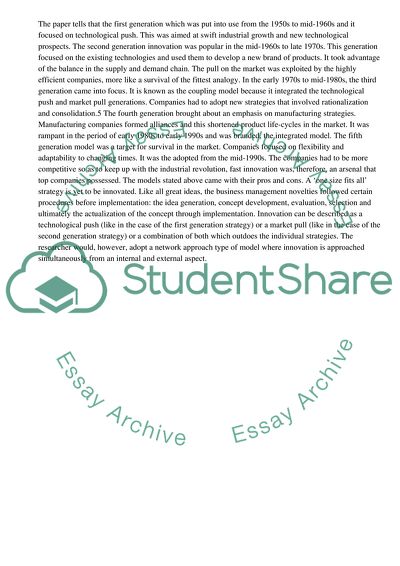Cite this document
(“Existing and Possible Generation Model Essay Example | Topics and Well Written Essays - 2000 words”, n.d.)
Existing and Possible Generation Model Essay Example | Topics and Well Written Essays - 2000 words. Retrieved from https://studentshare.org/business/1639452-roy-rothwell-introduced-the-5th-generation-model-in-the-1990s-the-innovation-process-has-substantially-moved-on-over-the-last-two-decades-first-critically-evaluate-each-of-the-5-models-and-then-formulate-a-possible-6th-generation-model
Existing and Possible Generation Model Essay Example | Topics and Well Written Essays - 2000 words. Retrieved from https://studentshare.org/business/1639452-roy-rothwell-introduced-the-5th-generation-model-in-the-1990s-the-innovation-process-has-substantially-moved-on-over-the-last-two-decades-first-critically-evaluate-each-of-the-5-models-and-then-formulate-a-possible-6th-generation-model
(Existing and Possible Generation Model Essay Example | Topics and Well Written Essays - 2000 Words)
Existing and Possible Generation Model Essay Example | Topics and Well Written Essays - 2000 Words. https://studentshare.org/business/1639452-roy-rothwell-introduced-the-5th-generation-model-in-the-1990s-the-innovation-process-has-substantially-moved-on-over-the-last-two-decades-first-critically-evaluate-each-of-the-5-models-and-then-formulate-a-possible-6th-generation-model.
Existing and Possible Generation Model Essay Example | Topics and Well Written Essays - 2000 Words. https://studentshare.org/business/1639452-roy-rothwell-introduced-the-5th-generation-model-in-the-1990s-the-innovation-process-has-substantially-moved-on-over-the-last-two-decades-first-critically-evaluate-each-of-the-5-models-and-then-formulate-a-possible-6th-generation-model.
“Existing and Possible Generation Model Essay Example | Topics and Well Written Essays - 2000 Words”, n.d. https://studentshare.org/business/1639452-roy-rothwell-introduced-the-5th-generation-model-in-the-1990s-the-innovation-process-has-substantially-moved-on-over-the-last-two-decades-first-critically-evaluate-each-of-the-5-models-and-then-formulate-a-possible-6th-generation-model.


